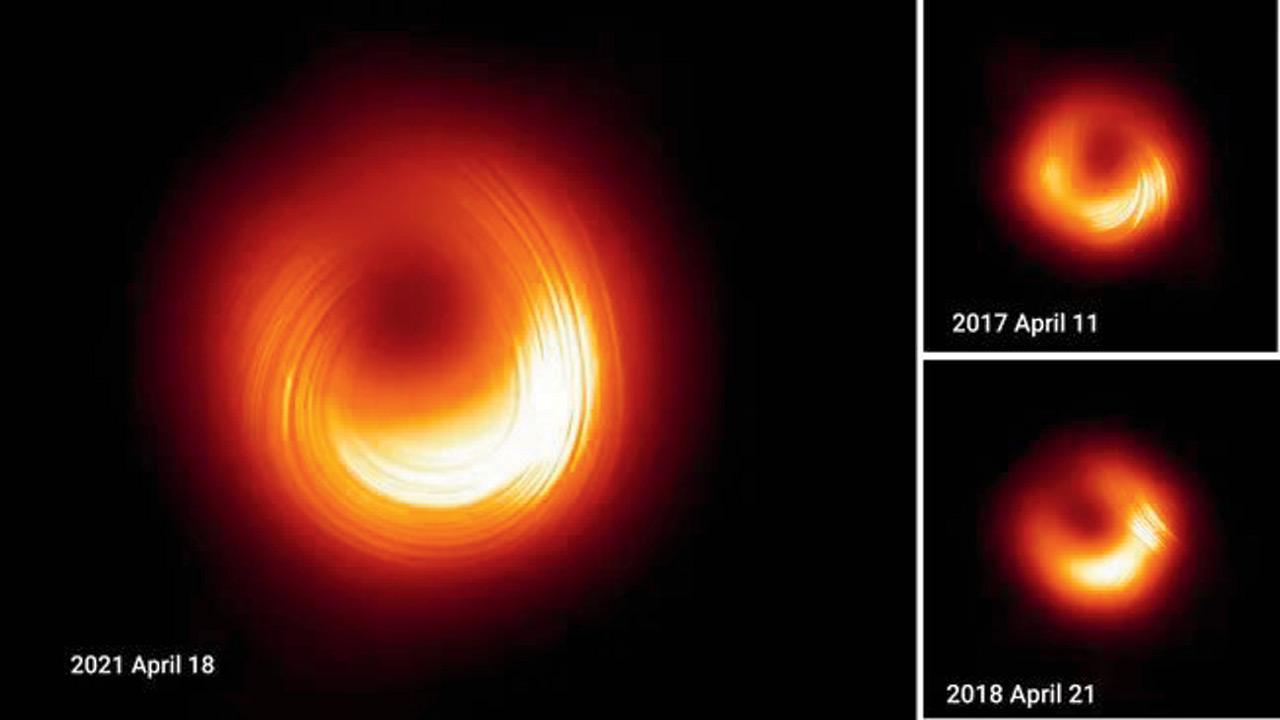Science
New EHT Images Reveal Magnetic Reversal in M87 Black Hole

The Event Horizon Telescope (EHT) has unveiled remarkable new images of the supermassive black hole at the center of the galaxy M87. Known as M87*, this black hole gained international attention in April 2019 when it became the first black hole ever imaged by humanity. The latest observations reveal significant changes in the magnetic fields surrounding M87* over a span of four years.
Located approximately 55 million light-years from Earth, M87* continues to be a focal point for researchers studying the extreme environments surrounding supermassive black holes. The new images illustrate a reversal in the polarization of the magnetic fields, a phenomenon that could provide insights into the behavior of matter in these extreme conditions.
The images also capture the unmistakable signs of a jet of matter emerging from the vicinity of the black hole. This jet’s base is intricately linked to the bright ring surrounding the outer boundary, or “event horizon,” of M87*. Such visual data is crucial for advancing theoretical models related to black holes and their environments.
Understanding the dynamics around M87* is essential for scientists aiming to comprehend how supermassive black holes, which can possess masses equivalent to millions or even billions of suns, influence their surrounding galaxies. The EHT’s latest findings contribute significantly to the ongoing research in astrophysics, particularly in areas concerning gravitational effects and energetic phenomena.
Following the groundbreaking discovery in 2019, the EHT team has continued to refine its imaging techniques, allowing for unprecedented observations of black holes. The reversal of magnetic fields around M87* may also have broader implications for understanding cosmic phenomena and the fundamental physics governing the universe.
These new insights from the Event Horizon Telescope reinforce the importance of continued research into black holes, which are not only pivotal to our understanding of the cosmos but also serve as a natural laboratory for testing theories of physics under extreme conditions. As scientists analyze this data, the potential for new discoveries about the nature of black holes and their role in the universe remains vast.
-

 World4 months ago
World4 months agoSBI Announces QIP Floor Price at ₹811.05 Per Share
-

 Lifestyle4 months ago
Lifestyle4 months agoCept Unveils ₹3.1 Crore Urban Mobility Plan for Sustainable Growth
-

 Science3 months ago
Science3 months agoNew Blood Group Discovered in South Indian Woman at Rotary Centre
-

 World4 months ago
World4 months agoTorrential Rains Cause Flash Flooding in New York and New Jersey
-

 Sports3 months ago
Sports3 months agoBroad Advocates for Bowling Change Ahead of Final Test Against India
-

 Top Stories4 months ago
Top Stories4 months agoKonkani Cultural Organisation to Host Pearl Jubilee in Abu Dhabi
-

 Science4 months ago
Science4 months agoNothing Headphone 1 Review: A Bold Contender in Audio Design
-

 Top Stories4 months ago
Top Stories4 months agoAir India Crash Investigation Highlights Boeing Fuel Switch Concerns
-

 Sports3 months ago
Sports3 months agoCristian Totti Retires at 19: Pressure of Fame Takes Toll
-

 Business4 months ago
Business4 months agoIndian Stock Market Rebounds: Sensex and Nifty Rise After Four-Day Decline
-

 Politics4 months ago
Politics4 months agoAbandoned Doberman Finds New Home After Journey to Prague
-

 Top Stories4 months ago
Top Stories4 months agoPatna Bank Manager Abhishek Varun Found Dead in Well









